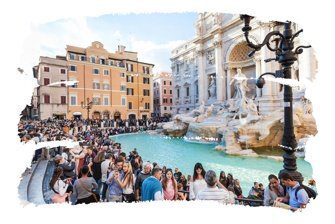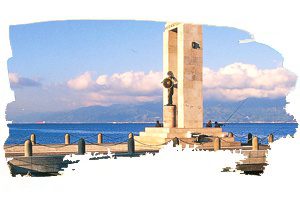Carrara: a pearl in Tuscany!
When we talk about Carrara, the word ‘marble’ immediately comes to mind, but did you know that Carrara has a lot to offer us? Today I take you to one of the pearls of the Tuscany region! Today I take you to visit Carrara. Ready? Here at Your Travel to Italy with Ana Patricia you make the trip of your dreams !!! ALSO: see our “Accommodation in Italy – Tips for your holidays!”.
Must-see video in Carrara!
Our Introduction
When we talk about Tuscany, some cities stand out: Florence, Pisa, Lucca, Volterra, but one of the little known cities, and that may surprise you, is the beautiful city of Carrara.
If we had to define the city with a single word, that word would surely be ‘brilliance‘! Carrara is a city that shines, is illuminated, is located between the sea and the mountain, and invites us to explore it without haste. With splendid buildings, the city makes you fall in love with it and becomes unforgettable in our minds and hearts. Today I take you on a tour of the magnificent Carrara.
Today the city of Carrara is known as the capital of marble and it could not be different, however, as we said before, the city goes beyond presenting us with incredible beauties! Discover here The most beautiful villages in Tuscany!
1) Carrara: a pearl in Tuscany! VISIT PALAZZO CYBO MALASPINA
We begin our tour from the city center and, there, we can already glimpse one of the most beautiful palaces in Carrara: Palazzo Cybo Malaspina. This palace is also called Palazzo Ducale and was, for a long time, the historic residence of the Cybo Malaspina family, lords of Carrara.
This building was built on the ruins of an old castle from the Lombard period and today it has two different nuclei: a medieval castle, with an imposing tower, and a Renaissance residence dating from the end of the 16th century.
Tip:
Inside the palace, you will find the splendid Academy of Fine Arts. The academy is the most important museum in Carrara and preserves an interesting archaeological collection with diverse sculptures. An edicule by Fantiscritti, which is a relief dating from the early 3rd century AD and depicting Hercules, Jupiter and Bacchus, deserves mention. A curiosity of this work: it was signed by famous people and, among the names, we can see ‘autographs’ of Michelangelo, Giambologna and Canova, who witnessed the passage of these masters there. In the museum you will also find several rooms with various works of art that are undoubtedly worth a visit. For more information, tickets and schedules, you can access the official website of the Academy.
2) Carrara: a pearl in Tuscany! VISIT THE HOUSE OF EMANUELE REPETTI
Leaving there, head towards House of Emanuele Repetti. Follow Via Verdi and cross the elegant Accademia Square to reach Via Santa Maria. Here you come across a medieval street that takes you to Piazza del Duomo (“Cathedral Square”). Before arriving there, you can already see the house of Emanuele Repetti, which is a beautiful building from the 13th century that, some time ago, was the seat of the Municipality of Carrara.
Emanuele Repetti was a great geographer, historian and naturalist born in Carrara who lived between 1776 and 1852. He was responsible for a monumental work known as the Historical Physical Geographical Dictionary of Tuscany. In this work are described all the localities of Tuscany. It is a gigantic work, very rich in details and, needless to say, beautiful!
3) Carrara: a pearl in Tuscany! VISIT PIAZZA DUOMO
Now head to Piazza Duomo. Its official name is Piazza Drent; It is a small square, but of a charming beauty. It has a long and narrow irregular shape and, on the sides, you can admire numerous buildings of medieval origin, with a very characteristic architecture, even if some of them have been remodeled over the years.
One of the palaces tells us that it was here that Michelangelo Buonarroti used to stay during his trips to the marble quarries. In the center of the square, observe the Giant, which is an unfinished statue depicting Andrea Doria as Neptune; it was created by the Florentine sculptor Baccio Bandinelli and is very beautiful.
4) Carrara: a pearl in Tuscany! VISIT THE DUOMO OF CARRARA
Since we are in Piazza Duomo, obviously we could not visit, of course, the Duomo of Carrara. The Carrara Cathedral began to be built in the 11th century and was only completed after three centuries!
Of course, it is entirely covered in marble and has two architectural styles: one part is in Romanesque style, the other in Gothic style. The facade was built in the 14th century and is of a unique beauty: it presents us with an alternation between strips of white marble and strips of dark marble, creating a very interesting look.
In the center of the façade, we can admire two elements of great value: the rose window and the portal, which is decorated with numerous zoomorphic sculptures that follow one another along its length. The interior has three naves divided by arches that, despite their beauty, are very simple. The church preserves some valuable marble works, as well as a 16th century pulpit, an image of Our Lady with the Child and the Saints, made by Andrea Guardi in 1460. The painted cross suspended over the high altar also attracts our eyes.
Be sure to admire the beautiful bell tower, which is behind the cathedral and separate from the church. The tower is 33 meters high and was built during the 14th century.
5) Carrara: a pearl in Tuscany! VISIT THE CHURCH OF OUR LADY OF TEARS
Leaving the Duomo, another must-see church is the Church of Our Lady of Tears. Walking for a short distance on Via Ghibellina, just after crossing the Ponte delle Lacrime (“Bridge of Tears”), we can already see this beautiful construction.
In front of the church you can see a beautiful fountain, Mermaid Fountain. In Baroque style, it presents us with a mermaid seated on a dolphin that squirts water that falls on a large shell. The statue, of course, is all made of marble.
Moving on to the Church, it was built in 1650 and is characterized by a beautiful portico with three arches that are supported by two columns and two marble pillars. Inside it, we can see the high altar that was created by Francesco Baratta in 1772. There is the venerated image of the Madonna delle Lacrime, which was painted in the 16th century by Giusto di Domenico Utes. We can also see a 17th century canvas depicting Christ crowning the Virgin, it’s a spectacle indeed!
6) Carrara: a pearl in Tuscany! VISIT THE ANIMOSI THEATER
We continue our tour until we reach the Animosi Theater. Through Via Apuana you reach Battisti Square. The Animosi Theater is already visible here, which is the main theater in Carrara.
The site was built in 1840 and features a beautiful neoclassical façade and is entirely covered in white Carrara marble; We are also struck by its Ionic pillars and columns; at the top, we see an elegant balustrade with garlands. On the left, we see the square where, in the center, there is a large statue representing Giuseppe Garibaldi made by the sculptor Carlo Nicoli.
6) Carrara: a pearl in Tuscany! VISIT THE PIAZZA ALBERICA
Another interesting point of the city is Piazza Alberica. Through the streets of the historic center, we take the last stretch of Via Ulivi to reach Piazza Alberica. A large and beautiful square surrounded by marble and prestigious buildings such as the Palazzo delle Logge and the Palazzo dei Conti del Medico.
In the center of the square we have a huge statue made in 1827 by the sculptor Pietro Fontana, which portrays the Duchess Maria Beatrice d’Este. The square is our last stop on our tour of the historic center of Carrara, and I’ll leave you with a tip: make a strategic stop for a coffee, or ice cream, and admire the movement of the city.
A Map to guide you in Carrara

Extra tip:
- Don’t forget to also visit the beautiful Sanctuary of the Madonna delle Grazie. Continuing along Via Carriona, you’ll find this sanctuary that deserves a visit, even if it’s quick. This church was built in 1620 to house only a fresco with the image of Our Lady from the small chapel of the Palazzetto del Principe, in Groppoli. Here you will find a sober facade and accompanied by a very well decorated interior that has as a highlight a majestic high altar where, evidently, is the image of the Virgin.
Carrara marble.
It’s impossible not to take the time to talk about Carrara’s star: marble! Carrara marble is famous and appreciated throughout the world. With its unique characteristics, it is widely used for various purposes such as coatings, works of art, buildings, among others.
Much loved by famous artists such as Michelangelo, it attracts many visitors to the Apuan Alps, where marble is extracted. Among the most famous statues made entirely of Carrara marble we can mention David and Pietà.
The most famous variety of this precious marble is white, but there are several colors available. In the quarries of Carrara, various types of marble are extracted, characterized by shades and veins of particular colors, making each stone unique. Among the various types of Carrara marble we find white marble, Statutario marble, veined marble, Arabescato marble, Calacatta marble, Bardiglio marble and Cipollino Zebrino marble. White marble comes in three different varieties that may contain more or less greyish ‘designs’; we are talking about white Carrara marble, Statuario and Calacatta.
The excavations of Carrara marble.
Marble is mined in the quarries of the Apuan Alps. The quarries of Carrara have been used since antiquity, mainly during the Iron Age, for the construction of entire necropolises and this is very visible in several fragments of marble found in many places over the centuries.
Although the quarries of Carrara had already been explored during the Iron Age, it was only in Roman times that the mining activity that originated the exports of the material began. The quarries of the Apuan Alps have been around for centuries, but it is not an endless source and, in a few more centuries, marble is likely to be gone.
Can I visit the quarries?
You must! The best time to visit is between April and October, and I suggest you avoid the coldest periods, as this is when the thermometer drops to minus 7 degrees and the roads are full of ice and snow, making access difficult.
How to get there?
The Apuan Alps area can be reached by car using the A11 Firenze-Mare motorway, exiting Lucca. From here, follow signs for Garfagnana. If you are coming from the north, use the highway exit to Sarzana; then continue along Via Aurelia towards Massa Carrara. The SP59 road is the one that takes you directly there!
Traveling by car in Italy
How about if I give you a rental car option? Are you ready for it? If you are renting a car be sure to read our posts in the section Driving in Italy on the blog Your Travel to Italy. In addition to car itinerary tips, we have everything about signage, tolls, roads and many more tips.
Don’t know where to rent the car?
We have a partner that can help you: Rent Cars! Have you ever thought about renting a car in Italy, without leaving your home? Click on the banner below to learn more! Search, compare and choose!
Gold Tip:
- Take an excursion to the Quarries of the Colonnata and Fantiscritti Basin! They will show you the entire process of extracting and working the marble. If you like the idea, you can go to Carrara’s official website and organize your visit! To do so, click HERE!
A little more about history
The city of Carrara was founded in an area inhabited by Ligurian-Apuana tribes, which after many struggles and persecutions were dominated by the Romans in the 2nd century AD The Romans began to explore the territory and discovered the almost infinite resources of the locality, mainly the marble quarries, in addition to the port city of Luni.
The exploration developed the region’s trade and strengthened relations with other localities. Undisputed is the trade in Carrara marble. The quarries were already exploited by the Etruscans, but their value came during the empire of Augustus. The first illustrious sculptors fell in love with these marbles and began to use them for their work.
The beauty of the stone added value and durability to the pieces and, thus, marble became a material much sought after by artists and art lovers. Carrara obtained its independence some time later, but not before passing through the ‘hands’ of some domains such as those of the Bishop of Luni, of Pisa, and finally by the Dukes of Modena. In the Middle Ages Carrara became a small principality that, some time later, joined Massa – which later gave rise to the province of Massa Carrara.
Watch this video and come with me in a baloon tour by Tuscany!
Subscribe to our channel and receive more videos with information and tips about Italy. Don’t forget to leave that Like;)
Conclusion
Carrara: a pearl in Tuscany! Carrara goes beyond marbles, but it’s impossible to ignore them! Evidently, the city goes much further and presents itself in an elegant, interesting and very attractive way! It is well worth your visit!
Are you insecure?
And if you feel insecure, have no time, and need help to organize your trip, don’t hesitate to contact me! I will love to help you make your dream trip to Italy come true. And how can I do that? Keep reading this post until the end and you will understand how we make your life and your trip much easier.
Did my post help you? If so, be sure to post your comment below, but if you still have questions just send me a message I will answer you as soon as possible!






 Save money!
Save money!